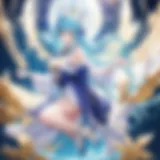In-Depth Review of One Punch Man Season 2 on Crunchyroll
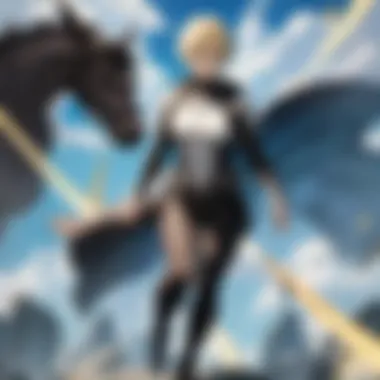

Intro
One Punch Man, originally a webcomic created by the artist ONE, has gained a dedicated following since its debut. It blends humor with the superhero genre, demonstrating a unique take on the traditional narrative aspects of anime and manga. Season 2 of this widely-loved series, made available on Crunchyroll, was released in 2019. It continued the journey of Saitama, a hero who can defeat any foe with a single punch.
The popularity of One Punch Man is attributed to its clever parody of superhero tropes and engaging character dynamics. However, Season 2 met mixed reactions compared to its acclaimed predecessor. Many existing fans were eager to see how the story would develop, while newer audiences might take time to adjust to this season's pacing and themes.
In this review, we will peel back the layers of Season 2, evaluating not just what happens through the episodes, but how it informs the larger conversation within the anime community. We explore character arcs, production nuances, and the cultural resonance of the series across different audiences. As fans and newcomers embarks on this engaging series, understanding these elements is essential.
Prologue to One Punch Man
The anime series One Punch Man occupies a distinctive place in the landscape of modern anime. To understand its facets, we first need to delve into its essence, lore, and significance. The show's unique blend of humor, action, and commentary on the superhero genre makes it worthy of closer examination.
Overview of the Series
One Punch Man began as a webcomic created by ONE. The narrative follows Saitama, a hero capable of defeating any opponent with a single punch. This premise allows for a satirical take on typical superhero tropes. Throughout its episodes, Saitama's journey highlights how power can lead to ennui rather than glorification.
Notable characters populate this vibrant world. Figures like Genos, Saitama's disciple, and various other heroes support and contrast his character. Through these relationships, the series explores themes of purpose, individuality, and societal expectations, wrapped in battle animations and comedic moments.
The appeal of One Punch Man extends beyond its storyline. The animation quality, character design, and humor generate an immersive experience. This combination contributed to the dramatic rise in its fan base, with many awaiting each season to see what new trials Saitama faces.
Historical Context and Cultural Impact
When One Punch Man debuted, it captured audiences looking for both action and satire. It emerged as part of a broader trend of anime that subverted established genre conventions. Alongside shows like Attack on Titan and My Hero Academia, it expanded the narrative lens of anime, incorporating dark humor and self-aware storytelling.
The cultural impact of One Punch Man can be observed through its influence. The series has successfully resonated within social and meme cultures. Phrases from the series often surface online, creating a humorous bond between fans. The show has become a reference point in debates regarding superhero narratives, prompting both admiration and analysis from audiences around the world.
Its dual nature — a hero devoid of challenge yet deeply reflective — poses questions about what it means to be a hero in a fabricated society. As fans navigate through One Punch Man, they reconnect with their reflections about heroism, humility, and the futility of over-ambition.
Thus, this introduction sets the stage effectively. It unpacks the joy and critique embedded within One Punch Man, preparing viewers for a deeper understanding as the exploration of its second season unfolds.
Crunchyroll: A Platform for Anime
Crunchyroll plays a significant role in the contemporary anime landscape. Established in 2006, it has transformed how audiences access manga and anime content. With a focus on simulcasts and a vast library, it has become a crucial platform facilitating the consumption of anime globally. In India, for example, rampant major streaming players have also decided to position administratively on relevant anime content. Supported by engaged user communities, Crunchyroll is instrumental in shaping cultural trends around the genre.
Prelude to Crunchyroll's Offerings
Crunchyroll presents a wide range of anime series, movies, and even drama series. The platform specializes in delivering, often shortly after the original broadcast in Japan. Notable features include free ad-supported streaming as well as premium memberships that enable an ad-free, high-definition experience. Such structures allow viewers with varying needs and capacities to access anime across numerous devices and platforms.
Beyond anime, Crunchyroll hosts exclusive content, merchandise, and community initiatives. The mandatory constant real-time discussions on forums generates engagement among fans worldwide. This social aspect heightens interest in content like One Punch Man, encouraging fans to continue exploring the series as notified discussions unfold over the network.
How One Punch Man is Presented on Crunchyroll
In the context of Crunchyroll, One Punch Man achieves a distinct balancing act between accessibility and presentation experience. Both seasons are available in varying language options, catering to widely diverse audiences. Options for subtitles and dubbing enrich the viewing experience, ensuring better audience translation as original wording frequently has niche meaning and retains barriers across different audiences.
Notalent exists solely in presentation here; through superior engineering, content appears seamless, responsive and, vivid—even at peak traffic moments. All these create an almost material allure effect for new reasons to resume ongoing stories. The unpadaptive method adeptly produces immediate availability of unexpected earlier episodes also adds noteworthily to audience anticipation in a society that rebels against boredom.
Recommend tracking audience growth on social hubs like reddit on templates set as so responses are easily meta-categorized. Monitors strongly assert remind eventdata when chapter numbers released elevate wondering if it could spur new satisfaction avenues among current evergreen members to začetirati all-consuming sentiments late birthdays resulting complicated relations into thinking about complex composite narratives belonging to established intervals beyond motives.
Character Development in Season
In exploring One Punch Man Season 2, character development serves as a crucial lens through which viewers can engage with both old and new personalities. Unlike transient elements like animation quality or soundtrack, character complexity fosters audience connection. This season illuminates further growth and perspectives for key figures, enriching the narrative and providing insights into their behaviors.
Returning Characters and Their Evolution
Returning characters such as Saitama, Genos, and Mumen Rider display notable evolution. Each continues their journey facing not just external foes but also internal challenges. For Saitama, this season digs deeper into his search for meaning. Despite being marked as overwhelmingly powerful, he confronts ennui in a world that seems increasingly mundane. This exploration adds depth, moving him from a one-dimensional hero into a more relatable figure.
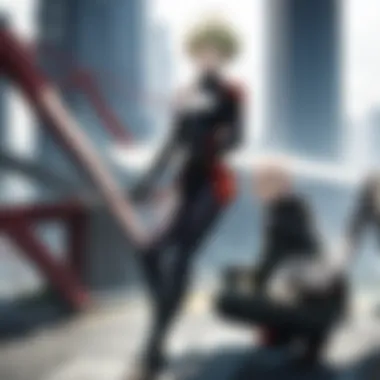

Genos's pursuit of strength embodies ambition and loyalty. His evolution not just emphasizes strength but highlights the struggle of growth under mentorship. The scenes depicting his fierce dedication to Saitama contrast with actual developmental milestones. Mumen Rider’s journey emphasizes perseverance over power, reminding how true heroism can exist outside raw strength.
As these characters grow, it is important to note how they interreact. The chemistry amongst them contrasts personal ambitions with camaraderie. This interplay is instrumental in driving key conflicts and outcomes impacting the story arc throughout this season.
New Character Prolusions
Season 2 introduces various compelling new characters, each carrying unique traits and backstories. Characters like Garou offer a formidable counter to the main heroes and challenge the narrative lines significantly. Garou embodies the struggle against a system that constantly elevates heroes, which juxtaposes with existing heroic tropes. This layered approach offers viewers a chance to view heroics from an unorthodox perspective.
Moreover, the introduction of the Monster Association shifts dynamics, presenting not just antagonism but complex narratives around what defines a 'monster.' Each new character contributes to enriching thematic discussions about morality, power, and ideology. These elements profoundly influence established heroes, prompting reevaluation of their ethics and their roles on which the society relies.
This process effectively enhances the series, shifting it away from a risque only background. Characters become dialectical elements asking viewers to sit with ethical dilemmas rather than straightforward victories. Character development in Season 2 ultimately shapes the audience's journey as much as the narrative itself, enhancing the investment in plots unfolding on-screen.
Plot Analysis of Season
Analyzing the plot of One Punch Man Season 2 is critical for understanding the series's trajectory and its reception among fans. This section delineates how the narrative evolves, its thematic undertones, and how these aspects intertwine with character arcs. Readers can appreciate the depth and complexity that Season 2 brings compared to its predecessor. A thorough examination of plot points and story arcs will shed light on why certain developments resonate with the audience while also illustrating the defining moments that shape the series.
Key Plot Points and Arcs
Season 2 introduces a range of pivotal events that contribute significantly to both the storyline and development of characters. Several central arcs can be identified:
- The Hero Association's Internal Struggles: The politics and rivalry within the Hero Association grow more pronounced, adding layers to the established hierarchy.
- The S-Class Heroes: The introduction of multiple S-Class characters expands on the conception of power, creating more dynamic confrontations and interviews between heroes.
- Garou's Arc: Garou, a self-proclaimed monster, provides a mirror to Saitama’s nonchalance. His development served as a commentary on the tension between monsters and heroes. As he battles various heroes, he questions their motivations and purpose, enriching the narrative.
- Monster Association Rising: By the season's conclusion, the formation and significance of the Monster Association emerge as a recognizable threat, setting stakes for future seasons.
The pacing shifts from comedic tones derived from mundane situations to intense buildups reflective of superhero narratives seen in mainstream comic culture. This variation can come poignant moments that resonate deeply within the core of thematic development.
Comparison with Season
When we discuss Season 2 in relation to Season 1, the differences arise from structural and tonal decisions. Season 1 thrived on its surprise factor, particularly the overwhelming strength of Saitama juxtaposed with often ridiculous stakes. However, Season 2 ventures into darker territories by placing spotlight on villains' backstories and their ethical standing.
Significant changes include:
- Character Depth: Season 2 permits more character exploration, emphasizing personal motivations over previous punchline-centric narratives.
- Themes of Entropy vs. Structure: The chaotic introduction of the Monster Association offers stark contrast to the seemingly organized Hero Association's facade.
- Shift in Animation Quality: While Season 1 was visually lauded, opinions shifted regarding artistry in Season 2, leading to debates about aesthetic preferences among loyal viewers.
Animation Quality and Art Style
The animation quality and art style are critical elements that define the viewing experience of One Punch Man Season 2. With anime, exceptional animation can elevate the storytelling, enhance character expressions, and intensify action sequences. It is noteworthy how One Punch Man uses these visual techniques to capture the essence of its premise, where a superhero effortlessly defeats all enemies with a single punch. As the series progressed into its second season, fans and critiquers alike became keen observers of these artistic evolutions, as they caused tangible shifts in both storyline impacts and viewer engagement.
Technical Aspects of Animation
In understanding the animation of One Punch Man Season 2, one must acknowledge the technical elements such as frame rate, fluidity, and color grading that contribute to an immersive atmosphere. The animation service for this season switched from Madhouse to J.C. Staff, which raised eyebrows. One yearned for the astonishing visuals that defined the first season.
The action sequences in Season 2, while commendable, sometimes lacked the brisk fluidity found earlier. The attention to framing and scene transitions also deserved scrutiny. In various battles, noticeable transitions disrupted the overall flow, leading to moments where less attention to detail was apparent. However, the fight movements still delivered stellar tension and helped create an enjoyable pulsing rhythm of action, even if inconsistent at times.
An observation that stood out is the application of shading techniques which contribute depth to the art. This felt more stylized than realistic. The efforts to distinguish between minor and major characters also echoed through dialogue and unique motion highlights, paving space for individuality in character designs.
Art Style Comparison between Seasons
When comparing the art styles of the two seasons, one’s undeniably aware of the shift prompted by the new animation studio. Although One Punch Man retained much of its distinctive identity, namely the humorously exaggerated character designs, tangible differences arose in overall aesthetic execution.
- Stylistic Consistency: The distinctively exaggerated features, large fingers, and nonchalant expressions remained present. However, character expressions felt muted as compared. The brightness and saturation, tracing characters, shared less depth, which sometimes made the viewing experience less rewarding.
- Background Art: Whilst Season 1 included cinematic backgrounds that rendered the settings to add flavorful immersion, the backgrounds in Season 2 often lacked that polished feel. They defined scenes reasonably, but the detailed layering sometimes came off as secondary to the character animations.
Soundtrack and Voice Acting
The soundtrack and voice acting are fundamental components in shaping the overall experience of an anime series. In the case of One Punch Man Season 2, these elements are particularly noteworthy as they contribute to the narrative depth and emotional resonance of key moments. A series' soundtrack can evoke specific feelings, emphasize thematic elements, or even foreshadow events. Similarly, the voice acting frames character personalities and enriches audience engagement. Understanding this dynamic is essential for an audience that seeks a deeper appreciation of the art form.
Theme and Background Music Analysis
The background music in One Punch Man Season 2 plays a critical role in delivering its motifs. The composition varies based on the emotional landscapes portrayed onscreen, adapting to match transformations in the plot and intensity of scenes.
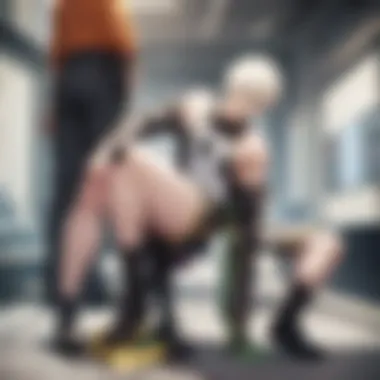

Consider the opening theme, “The Hero!!,” which reflects themes of heroism scattered throughout the series while incorporating a fast pace that aligns with action sequences. The character-focused score makes transitions between humor and suspense seamless, creating a captivating sensation for viewers.
Key points often expressed in discussions revolving around the music include:
- Integration of Themes: Each track frequently distinguishes between different situations, such as the contrasting days of despair versus moments filled with triumph.
- Cohesiveness: The music builds a cohesive auditory environment, which effectively pulls viewers into the world of the show.
- Emotional Elevation: As pivotal scenes unfold, the shifting nuances can elicit responses from laughter to sadness.
Rio Yoshihari’s musical compositions in the season have successfully supplemented the overarching tones of the show. On platforms like reddit.com, you often find fans openly debating about specific tracks, which shows that music deeply influences viewer sentiments.
Voice Cast Performance
The voice acting in One Punch Man Season 2 deserves particular attention. This aspect elevates various characters and shapes audience perception, enhancing the grandiosity of their exploits. Each actor brings their interpretation, governed by written material. This results in an distinctive synergy that affects the series' entire atmosphere.
Notable points regarding the voice cast in this season are:
- Returning Performers: Key figures preached old roles, contributing to continuity whilst being pivotal for returning viewers.
- New Comers: The introduction of characters came with new voice talents, adding fresh dynamics to muted interactions.
- Character Reflection: Voice actors imbue characters with personality traits that are often subtle yet impactful. For instance, Saitama's calm demeanor juxtaposed with the explosive anger of characters like Garou enriches written dialogue.
Audiences discuss performances extensively across forums like facebook.com and reddit.com, often leading to in-depth evaluations of individual actors’ work.
Reception and Critique
The reception and critique of One Punch Man Season 2 are critical to understand how this season was perceived within the wider anime community. The analysis of viewer reactions alongside professional critiques provides insight into the effectiveness of the story and how well it was able to capture the attention of its audience. This section will delve into viewer ratings and responses, presenting the scale on which this season was received in comparison to its predecessor. Additionally, examining expert reviews can unveil important details about strengths and weaknesses within the show that may not have been immediately apparent to casual viewers.
Viewer Reactions and Ratings
After the eagerly awaited release of One Punch Man Season 2, fans were quick to express their thoughts. Viewer reactions varied significantly, reflecting a mix of excitement and disappointment. Many fans appreciated the continuation of beloved character arcs, while others felt that the season did not meet the expectations set by the first season.
Viewer ratings are essential indicators of overall satisfaction. On platforms like Crunchyroll and MyAnimeList, Season 2 received scores that hovered around a mix of 7 to 8 stars, a notable drop from the overwhelmingly positive reception of Season 1. The divergence in ratings stirred discussion and debate among the community.
Some viewers pointed out several positive aspects:
- Development of supporting characters
- The engaging introduction of new villains
- Unique thematic explorations
Conversely, numerous audience critiques pointed to areas that left them unsatisfied:
- A perceived drop in animation quality
- Narrative pacing issues
- Unlikeable antagonist development
These irrefutable viewer perspectives shape a broader understanding of Season 2 and its position in the series as a whole. The animated adaptation itself, combined with viewer opinions, plays a large role in determining the future resonance of One Punch Man with its fan base.
Critical Reviews and Commentary
Critical reviews from professional anime analysts and platforms provide a different lens through which to assess One Punch Man Season 2. Critics approached the season with expectations influenced by the first, more stellar run. In several reviews, pundits scrutinized aspects of production quality and overall storyline coherence.
Many critiques echoed viewers' sentiments concerning animation quality. In particular, the switch in key production staff raised eyebrows. The animation studio J.C. Staff, tasked with bringing the second season to life, contracted differently than the previous studio. This decision resulted in discussions over how certain key scenes failed to deliver on the same visual sophistication that One Punch Man became famous for.
Moreover, critical discussions often highlighted thematic exploration, suggesting not all changes were negative per se. Themes related to society and heroism allowed deeper artistic exploration. Reviewers noted effectiveness in showing how realistic motivations can complexify character actions and responses.
Ultimately, the variety of critical perspectives contributes to a spectrum of feedback. It’s through this balance of viewer response and criticism that one can begin to grasp One Punch Man as a series that looks to push its creative boundaries, albeit unevenly at times. The critique, detailed and multifaceted, presents an essential tool to gauge the necessary changes and reflections for potential future developments in further seasons.
Thematic Elements in Season
The second season of One Punch Man introduces a series of thematic elements that enrich the narrative and offer more depth to the characters. As with any well-developed storyline, these themes act as a foundation, revealing the writers' insights related to heroism, growth, and societal expectations. By examining these elements closely, we gain a clearer perspective on how Season 2 connects emotional arcs and broader social commentary.
Exploring Major Themes
One prominent theme in Season 2 is the idea of what it actually means to be a hero. The show scrutinizes the conventional archetype of a steadfast hero, choosing instead to emphasize the varying motivations behind different characters' heroics. We see characters like Saitama, who has almost detached feelings about being a hero because of his overwhelming power, juxtaposed against those who aspire to gain recognition, such as Genos and others within the Hero Association.
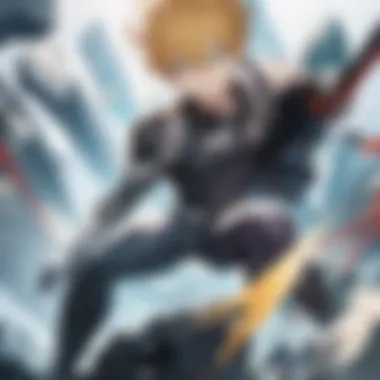

Another key theme is the concept of growth, not just in power but in understanding one's role and purpose. Many characters confront their own limits, leading to crucial moments of self-discovery. This transition encapsulates both internal and external challenges they face, which subsequently shapes their evolution over the season.
- Heroism and its Complexity: Focuses on varying motives behind being a hero.
- Growth and Self-Discovery: Highlights the characters' internal struggles and external challenges.
Symbolism and Motifs
The artistic choices made within the series work to strengthen its themes through symbolism and motifs. One of the more significant symbols is the Hero Association, which can be seen as a representation of societal expectations. It often creates a contrasting image of what society idolizes versus the true nature of strength depicted through characters like Saitama.
Furthermore, anime employs repeated motifs, such as the ‘Might vs. Right’ philosophy. The series takes aim at the idea that strength should equate to moral superiority, and it challenges viewers to think critically about these moral framings. Characters like Garou, who is labeled as a villain yet embodies a different kind of justice, perfectly capture this essence.
To summarize:
- Hero Association: A metaphor for societal norms regarding heroes.
- Might vs. Right: Questions the ethical implications behind power.
Future Prospects for One Punch Man
The discussion surrounding the future prospects for One Punch Man is essential in understanding the ongoing relevance and evolution of the series. With the conclusion of Season 2, fans and new viewers alike are intrigued by what direction the story will take next. This interest is not only about the characters and overarching narrative but also about the ways in which the anime can innovate within the genre.
Potential Directions for Subsequent Seasons
As the series continues, several key themes and arcs from the original manga may pave the way for future adaptations. Notably, the source material by ONE contains extensive character development and an intricate plot that can support multiple seasons.
Some potential directions that may emerge include:
- Further Exploration of Saitama's Identity: One prevalent theory suggests deepening the exploration of Saitama's quest for purpose and the nuances that come with being overpowered. This could add layers of complexity to the protagonist.
- Expanding the Hero Association Towards Politics: The story might shift focus toward the interaction between the Hero Association and political dynamics, underlining societal issues prevalent in the metro during battles and hero duties.
- Introduction of More Villains: There are many intriguing characters within the manga that have yet to be introduced in the anime. Many fans look out for how these nuances will showcase Saitama's reactions to fresh challenges aside from the ludicrous battles.
Understanding these potential paths is vital as they could radically alter perceptions around both returning and new characters throughout One Punch Man's narrative structure.
Speculations from Fans and Analysts
Speculations in the fan community surrounding One Punch Man have gained noticeable traction. Given the varying opinions on the adaptation process and content involved, different aspects of the future direction are rendered:\n
- Visual and Presentation Quality: With technology progressing, viewers often wonder how animation quality will adapt. Analysts anticipate that production studios may strive to revert or surpass the visual grandeur of Season 1.
- Narrative Density: There's a lively discourse regarding pacing. Some fans speculate adjustments will be made to keep episodes dense and rich in storytelling while maintaining laughter and simplicity.
- Manga vs. Anime: The divide between manga ardents and those who watch the anime is palpable. Analysts emphasize that diverging path of adaptations might be under scrutiny as discussions grow surrounding potential differences between illustrated story arcs and animated presentations.
“The diverting plots and rigorous engagement of characters may enrich the overall tonal assessments as fans endeavor to witness their beloved heroes resurge in animated displays. Understanding this realm anticipates future critiques as the story further unfolds.”
The future passion within the anime-loving community speaks volumes to One Punch Man’s progressive viability, from character relationships to psychological narratives. Exploring these anticipations reveals attractive avenues the franchise still holds.
Culmination
The conclusion serves a crucial role in tying together the various aspects discussed throughout the article concerning One Punch Man Season 2. It crystallizes the examination of the series by offering a concise summary while underscoring the significance of character development, plot intricacies, and the overall reception within anime culture. By reflecting on both the season's shortcomings and achievements, it provides readers with a balanced perspective.
In respect to the season's overall impact, it's essential to acknowledge how these elements resonate with the audience. Factors such as animation quality and voice acting are not simply technical specifications but contribute to the essence of storytelling in anime. They enhance viewer engagement, shaping how characters and plots are perceived. Thus, a comprehensive understanding of these elements is vital for anyone who seeks to analyze or appreciate the show.
Furthermore, this evaluation contemplates how One Punch Man Season 2 positions itself in the context of the wider anime landscape. It presents an opportunity for audiences to recognize how such works can reflect, challenge, or amplify cultural narratives. This critical lens opens avenues for discussions about thematic relevance, viewer expectations, and media impacts. Readers are left with considerations that could prove beneficial as they explore future content.
The conclusion about the significance of One Punch Man ultimately contributes to the original goal of this article: offering insight that is meaningful not only to established fans but also to those new to the series. The reflections shared aim to kindle further discourse, invoking curiosity and appreciation among the anime and manga enthusiasts.
Summarizing the Season's Impact
One Punch Man Season 2 influenced the anime landscape in several notable ways. While fans had high expectations after the first season’s success, this installment carved its space, albeit with mixed responses. A primary impact was the introduction of new character dynamics. The evolution of existing characters into more complex portrayals garnered significant commentary. Fighters like Garou stirred conversations about the nature of heroism and villainy. This created fertile ground for fan theories and speculation.
Additionally, while some criticized the animation quality compared to its predecessor, the series still maintained a unique visual allure. It made a noticeable effort with tonal changes that suited the story arc, despite some fluctuations. The sound design and voice acting contributed positively, enriching character portrayal and heightening emotional engagement in key scenes.
Season 2, through its varied storytelling, encouraged fans to interact across platforms and share their thoughts. It actively fostered community discussions about character motivations, allegiances, and overarching themes, mainly encapsulating ideologies prevalent in contemporary society. In summary, the season significantly broadened perspectives on character integrity and the moral complexity embedded in its narrative.
Final Thoughts on One Punch Man's Legacy
The legacy of One Punch Man persists not only due to its comedic undertones and action-packed sequences but also its subversion of traditional anime norms. Its ability to challenge hero tropes and inject satire into the genre cannot be underestimated. This complexity resonates across demographics, allowing it to remain relevant years after its release.
One Punch Man Season 2 is crucial to understanding how storytelling in anime can reflect deeper societal themes while maintaining engaging entertainment. It facilitated conversations centered around what heroes represent today. This evolution prompts questions about human experience in contemporary settings. Sentiments expressed on platforms like Reddit provide insights into community and fan discourse on these profound markers of social clarity.
To conclude, as One Punch Man continues to evolve, its intricate framing of heroism will remain relevant. Besides merely captivating viewers, this anime instigates reflection on personal ideals, perceptions of strength, and cultural commentary. As fan's await future developments, One Punch Man etches itself firmly in the tapestry of anime legacy, echoing through seasons and culminating every artwork that embraces meaningful storytelling.
